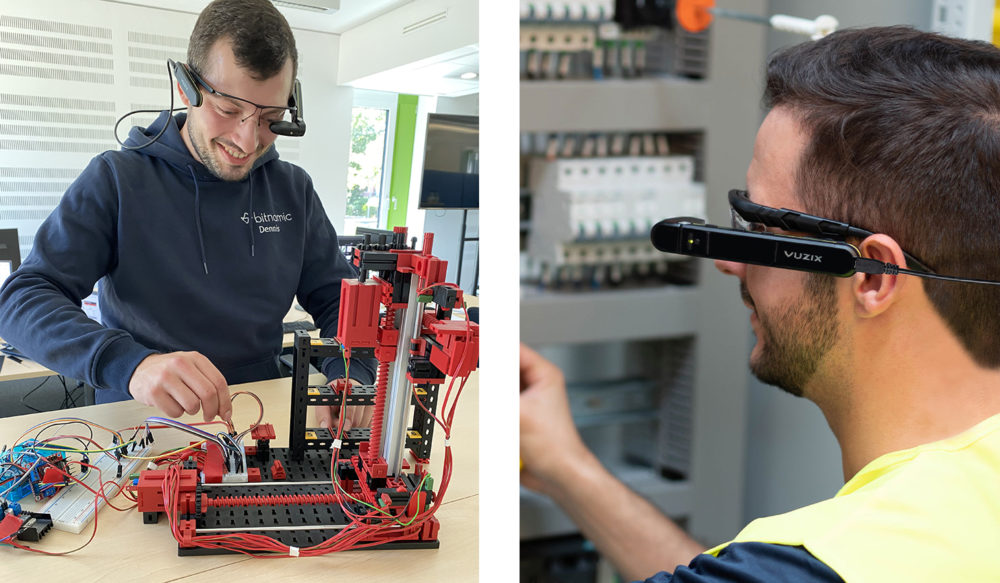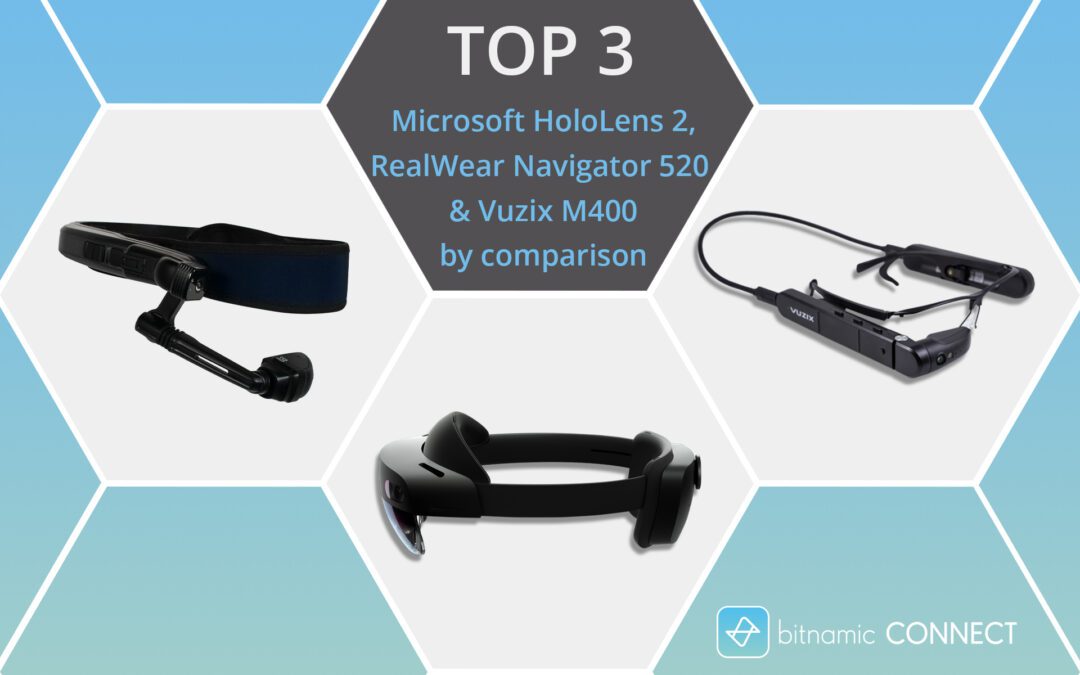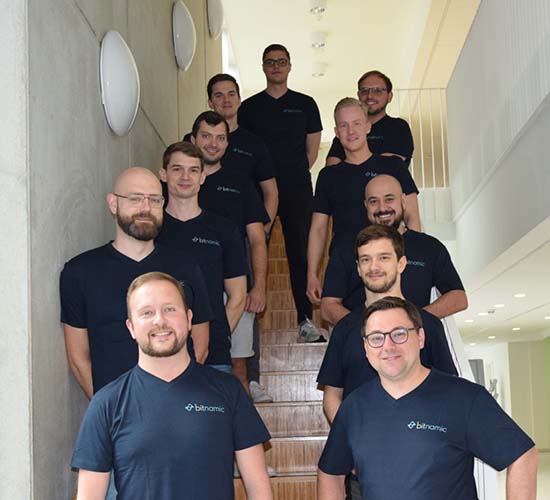A central machine needs maintenance or breaks down, the problem cannot be solved right away. This means: production stop, high costs and time-consuming traveling of an expert to the plant on site.
With the help of smart service solutions such as bitnamic CONNECT, downtimes can be shortened and travel costs saved – especially in combination with augmented reality, or AR. In contrast to VR (virtual reality), real sensory stimulation remains present in AR. This means that reality is not replaced by a virtual world, but merely extended by virtual elements.
Augmented reality can be used with the aid of AR glasses, for example. Special smart glasses for industry are ideal for service and maintenance processes.
Based on our experience, we recommend the following three smart glasses for industry: Microsoft HoloLens 2, RealWear Navigator 520 and Vuzix M400.
In the following article, you will learn about the advantages of using smart glasses in industry, the differences between the mentioned individual models, and which smart glasses are suitable for which areas of application.
Smart glasses in industry – Advantages of Remote Maintenance
Executing maintenance and service processes efficiently regardless of location – digitization in the form of remote maintenance makes it possible. Software solutions like Remote Maintenance, the main component of bitnamic CONNECT, connect a service technician on site with a remote expert in an interactive video conference.
Simply started via app, solutions can be communicated quickly and easily. Useful functions such as data exchange, laser pointer or the integrated whiteboard, which can be used to create screenshots and make annotations, additionally accelerate trouble-shooting.
Even better traceability and easier working on machines ensures the combination of Remote Maintenance and smart glasses: Smart glasses display context-relevant information directly in the user’s field of vision via an integrated camera – the expert sees what the technician sees. Smartphone, tablet or laptop are no longer needed. Thus, the technician on site has both hands free and can follow the instructions of the expert step by step.
The best smart glasses for industry
Augmented reality offers new opportunities regarding maintenance and servicing processes in industry. Practical use is efficient and intuitive – with the right smart glasses.
In our bitnamic CONNECT smart glasses guide for augmented reality maintenance you will find more information about AR and the models described below. All three smart glasses are compatible with Remote Maintenance. For a live demonstration, please make an appointment with our sales team.
Test: Microsoft HoloLens 2
The Microsoft HoloLens 2 are mixed reality smart glasses that augment reality with virtual three-dimensional elements by integrating them into the wearer’s field of vision. The objects can be placed anywhere and always remain in their original position thanks to spatial anchoring, even if the user changes his position.
The camera of the head-mounted display (HMD) is located directly in the center, so the expert’s view is almost identical to that of the HoloLens wearer. The smart glasses are controlled by voice command, so that both hands are always free to work on the machine. The smart glasses can also be controlled with gestures.
Test: RealWear Navigator 520
In contrast to the AR glasses by Microsoft, the Android-based RealWear Navigator 520 do not have a direct reality overlay – it is more like “AR light“. The model has a camera attached to the side of the head and a 2D assistant screen located in the peripheral field of vision. The smart glasses are controlled by voice, with the addition of an action, forward and back button. However, these are hardly needed due to the excellently functioning voice control.
Information can be exchanged via the screen of the RealWear Navigator 520 using Remote Maintenance. This allows the service technician to transmit his field of vision to the expert. In parallel, data such as videos, 3D models, documents, application windows, etc. can be received from the helpdesk via screen sharing. The integrated microphone also enables verbal communication.
Test: Vuzix M400
The Android-based Vuzix M400 also does not have a direct reality overlay. The smart glasses have a 2D display in front of the left or right eye, too, but the camera is located directly in front of the display in this model.
The M400 can be operated via touchpad, head movement or speech. Just like the HoloLens 2 and the HMT‑1, videos, pictures, documents, 3D models, etc. can be exchanged between the expert and the wearer of the smart glasses via Remote Maintenance.
Smart glasses for industry by comparison
Basically, the HMT‑1 and the M400 have more in common, while the smart glasses by Microsoft clearly differentiate themselves visually, technically and in terms of price.
The display
The display of the HoloLens 2 is equipped with transparent holographic lenses and is located in front of the wearer’s eyes in the form of a visor. The centrally located camera directly above it ensures that the perspective of technician and expert is almost congruent.
The camera as well as the display of the Navigator 520 and M400 are mounted on the side, but the viewing angle can be easily adjusted. In terms of camera quality, the Navigator 520 is well equipped: The HyperDisplay has an HD resolution of 1,280 x 720 pixels, has high-contrast color reproduction and a 24° field of view.
Ergonomics
The weight of the HoloLens 2 is 566 grams and turns out to be the highest compared to the other two smart glasses. Due to the ergonomic design and the option to flip up the display, it still excels in wearing comfort.
The Navigator 520 is slightly lighter at 274 grams, while the M400 weighs just 190 grams, making it one of the lightest smart glasses on the market.
Battery life
There are significant differences in terms of battery life: the HoloLens 2 can be actively used for about two to three hours. The runtime of the Navigator 520, on the other hand, is six to eight hours.
The M400 is roughly in between: Depending on the choice of external battery, its battery lasts for two to twelve hours.
Possible use of smart glasses in industry
In terms of robustness, the Navigator 520 ranks first: it is insensitive to dust, dirt and falls from a height of up to two meters on concrete. Fully functional in extreme cold or heat (from ‑20°C to +50 °C) and jet-water proof with an IP of 66, the smart glasses are especially suited for outdoor use.
 Foto: realwear.at
Foto: realwear.at
The M400 is also drop-proof, dust-proof, and protected from temporary submersion in water with an IP of 67. It is slightly more fragile than the HMT‑1, but also designed for wet, dusty environments.

Both smart glasses just mentioned are commonly used on construction sites, in production, the oil industry, gas industry as well as the automotive industry due to their (structural) properties.
The Microsoft HoloLens 2, especially its display, is more sensitive and therefore ideal for indoor use. It is mostly being used in healthcare and in the manufacture of complex products.

Smart glasses for industry – The most important data at a glance
| Microsoft HoloLens 2 | RealWear Navigator 520 | VUZIX M400 | |
| Display | Head-mounted display, mixed reality | 2D assistance screen placed on the side | 2D assistance screen placed on the side |
| Control | Voice, gesture | Voice | Touch pad, voice, head movement |
| Weight | 566 g | 274 g | 190 g |
| Battery | 2–3 hours | 6–8 hours | 2–12 hours |
| Price | 3.849,00 EUR | 2.999,00 EUR | On request |
| Field of application | Interior | Exterior, interior | Exterior, interior |
Smart glasses that are not suitable for industry
With the rapid expansion of digitization in the industrial sector, the range of smart technology is growing at the same time. This also applies to smart glasses, but many models are not suitable as smart glasses for industry.
Google’s smart glasses like the Google Glass Enterprise Edition 2 weigh only 80 grams, which makes them particularly light and therefore comfortable to wear for longer periods of time. However, it is not designed for more extreme weather conditions, contact with water, dust or dirt – in other words, for outdoor use or “rough” indoor use. Google stopped selling the Google Glass Enterprise in March 2023. However, the company seems to already be working on the prototype of a new smart glasses model.
The Magic Leap 2 is also small and light, but less suitable for use in (heavy) industry than in the fields of medicine or training.
Among the better-known smart glasses are models from Oculus, such as the Meta Quest 2. These are classified as VR glasses, i.e., they provide complete immersion in a virtual world. In the context of maintenance, repair and service, an extension of reality and thus the use of augmented reality or mixed reality is recommended. VR glasses such as the Oculus Quest 2 or the HTC Vive are therefore primarily found in the gaming sector.
Smart glasses for industry and Remote Maintenance for more efficient workflows
Remote maintenance in combination with smart glasses is the next step towards Industry 4.0. It ensures shorter production downtimes, lower costs and a better CO2 balance, as time-consuming travel can be avoided. Especially in these challenging times, more and more companies attend to the digitization of their workflows.
Bitnamic GmbH specializes in making companies fit for this digital transformation. Make your maintenance and service processes simpler and more efficient, and strengthen customer loyalty by solving problems quickly.
Arrange a non-binding demo appointment in which our Sales Manager Christopher Poelker will introduce bitnamic CONNECT to you.
If you are interested, we can also advise you on the topic of smart glasses and augmented reality – together, we determine which model is the most suitable solution for your company.


